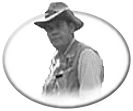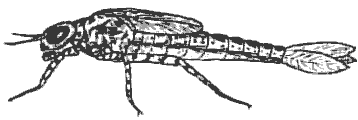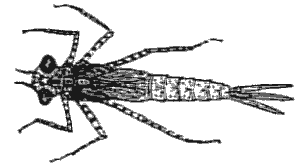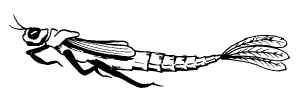 DAMSELFLIES DAMSELFLIES
article
by Ron Newman
Scientific Name:
Class
- Insecta. Order - Odonata. Suborder - Zygoptera. Family
- Coenagrionidae
Common
Names:
Damselfly,
Damsel, Narrow Wing, Bog Dancer
General:
As adults,
dragonflies and damselflies are often mistaken for each other. However,
damselflies can fold  or
close their wings over their back and parallel to their body. Dragonflies
cannot do this. Also, the damsels generally have a much narrower body
and finer features. On most of our Interior lakes, damsels are the small
blue ones that will often sit on the tip of your fly rod when you are
not retrieving and are usually seen more frequently than dragonflies. or
close their wings over their back and parallel to their body. Dragonflies
cannot do this. Also, the damsels generally have a much narrower body
and finer features. On most of our Interior lakes, damsels are the small
blue ones that will often sit on the tip of your fly rod when you are
not retrieving and are usually seen more frequently than dragonflies.
Life Cycle:
Most damselflies
complete a life cycle in one year but some species take two years. The
adults mate over the shallow water, sometimes in flight but often while
clinging to the exposed portions of weed beds or shoreline vegetation.
Immediately after mating, the female will crawl down the vegetation, and
'into' the water to lay her eggs on the submerged portion of the vegetation.
Once the eggs are laid she will crawl back up the vegetation and repeat
the process. When the eggs hatch they do not go through the larva and
pupa transformations. The newly hatched damsel is just a smaller version
of the later immature stages. Thus they are simply called 'nymphs' until
they actually hatch into adults.
The damselfly
nymph is very predacious. Usually it lies in wait for other aquatic bugs
to get within range and then grabs them with its 'labium' which is much
like a modified lower jaw. The nymph will proceed through 10 to 12 "instars"
or molts before becoming fully developed and ready to emerge as an adult.
With each molt the nymph becomes somewhat darker in color. Finally the
nymph will swim towards the shore and crawl up the shoreline vegetation.
While clinging to this vegetation the nymphal skin breaks along the wing
case and out crawls a shortened version of the adult. Before taking flight,
the new adult must pump body fluids into its abdomen and wings. This causes
both to lengthen into the familiar form seen skimming over the lake. Depending
on the species, the adult will live for several weeks to several months
before mating and dying. Meanwhile the nymph of the next generation will
migrate to the deeper water in the fall. It will hibernate over winter
and return to the shallow water the following spring to begin the process
anew.
Appearance:
The adult
has four wings that fold over the back. The male of the most common variety
in the interior is blue while the female is more of a slate color. For
the nymph, a fairly large and bulbous head sits on a tubular shaped body.
The eyes of the damsel are fairly pronounced but not as large or pronounced
as the eyes of a dragonfly nymph. The tail is three feathery looking appendages.
The tail is called the "caudal lamellae" and is actually three gills at
the end of the abdomen. In the early stages of the nymph the body parts
are not very distinct and the nymph is very dainty looking. It looks more
like a walking stick.
Size:
The damselfly
nymph gets up to about 25 mm long (one inch) when ready to hatch into
an adult. Younger generations will also be in any lake and these will
vary in size depending on the age.
 Colour: Colour:
When getting
ready to hatch, the damselfly nymph is usually darker in color than the
younger versions. It is often a dirty olive green to a brown color. Smaller
nymphs of earlier generations are normally much lighter in color and vary
around tones of water green to yellow-green and occasionally even a bright
blue-green. Locally the adult male is usually a bright blue while the
female is more of a slate color.
Movement:
The nymph
is usually stationary clinging to bottom vegetation and debris. When it
does move, it crawls or swims much like a fish by sweeping the tail back
and forth. Progress is not very fast and sometimes the damselfly nymph
will stop and remain motionless in the water or on the bottom for a period
of time.
Habitat:
Damselfly
nymphs are hatched in shallow water and tend to stay in the shallows among
weed beds where food is plentiful. They may by found in running water
but seen to prefer the marshes, ponds and lakes. They usually stay in
shallow clean water but may be found to depths of 35 feet.
 Importance
to Fly Fishing: Importance
to Fly Fishing:
The adult
damselflies are seldom consumed by trout in our interior lakes and thus
are not of much importance to the fly fisher. However, the damselfly nymph
ranks as the sixth most importance food source for our trout. Hatches
and migrations mostly occur during mid-day and feeding samples indicate
that damsels are taken much more frequently during the daytime. The samples
show that about 5% of the daytime feeding is on damsels and only 1% of
the feed for fish caught in the evening or after dark.
My gut feeling
tells me that damsels are actually more important than the samples indicate.
During the peak of the spring, fall and hatching migrations it is often
difficult for the fly fisher to catch many trout. I suspect that during
these times the fish are actively eating many damsels. However, with the
thousands of real damsels to choose from, the fish will simply ignore
anything but a perfect imitation and presentation. The imitation isn't
difficult but the presentation is a real challenge because the damselfly
nymph swims like a fish. Any fish that has already satisfied its initial
hunger will likely become very selective and avoid a damsel that isn't
moving correctly. Therefore, many of my samples are most likely from fish
just beginning to feed and are not yet stuffed with damsels. If these
assumptions are correct, then I have underestimated the importance of
the damselfly to fly fishers.
Migrations:
Damselflies
have a spring and fall migration linked with hibernation. During migration,
they are exposed and actively fed upon by the trout. After ice-off the
water begins to warm. The damsels come out of hibernation and migrate
to the shallows for feeding. In the fall as the water cools, the process
is reversed. The timing of these migrations varies with water temperature
and thus elevation. On average, the spring migration seems to coincide
fairly close to 'turn-over' on the lake and the fall migration seems to
be well under way by late October.
Hatches:
There are
several hatches from nymph to adult. The peak occurs about the second
to third week in June. There is an early emergence round about May 10th
and another secondary hatch in mid-July. When the damselflies do hatch,
it is usually during mid-day and the damselflies come to the shoreline
weeds in great numbers. Fishing can often be slow during a major damselfly
hatch. There are such vast numbers hatching at once that an artificial
fly is lost among the real thing. The fly fisher usually has more success
during minor damselfly hatches or at the very start of a major hatch.
Adult:
The adult
damselfly is not normally a food source for the trout in our interior
lakes and thus is of little importance to the fly fisher. Seldom are adult
damsels found in a feeding sample.
Nymphs:
The nymph
of the damselfly is by far the most important stage to the fly fisher.
The trout eat damsels from shortly after ice-off until it is too cold
for me to fish. When tying flies to imitate the damsel I would suggest
you make a well-defined head and be sure to represent the caudal lamellae
or three pronged tail. Those combined with a tubular shaped body and legs
should do the job. Color should be a darker green (olive) in the hatching
season. Color should be a light green in the fall months and decrease
the size of the fly.
I have seen
various methods to try to imitate the swimming motion of the damselfly
nymph. Wiggling the rod tip with a dry line and a very short leader, fluffy
flies that undulate with short pulls, etc. I don't feel that any of those
methods have worked very well. My most successful method has been to 'still
fish' the damsel. I let it sit as if it were resting between swims with
an occasional movement to attract attention. I almost always use a dry
or floating line for this approach. Sinking lines tend to get hung up
in the bottom vegetation too frequently or you have to retrieve too fast.
Try a weighted fly for down deeper or a non-weighted fly for near the
surface.
When you
see the very first damsels climbing up the shoreline weeds to hatch is
the best time to try an imitation of the damsel. Don't wait until the
hatch is in full swing. Avoid the competition with the real bug and get
the fish while they are actively looking for those damselfly nymphs. If
fishing is slow in the early spring or late fall, that may also be a good
time to try a damsel.
Recommended
Fly Patterns:
Larva:
- Marabou
Damsel Nymph
- Beaded
Damsel
- Stump
Damsel
- Cariboo
Damsel
- Seal Fur
Nymph
- Damsel
Halfback
Be
sure to read other articles by Ron Newman
Study
Other Insects
| Tip & Techniques
| Study Fly Patterns
| 


 DAMSELFLIES
DAMSELFLIES or
close their wings over their back and parallel to their body. Dragonflies
cannot do this. Also, the damsels generally have a much narrower body
and finer features. On most of our Interior lakes, damsels are the small
blue ones that will often sit on the tip of your fly rod when you are
not retrieving and are usually seen more frequently than dragonflies.
or
close their wings over their back and parallel to their body. Dragonflies
cannot do this. Also, the damsels generally have a much narrower body
and finer features. On most of our Interior lakes, damsels are the small
blue ones that will often sit on the tip of your fly rod when you are
not retrieving and are usually seen more frequently than dragonflies.
 Colour:
Colour:
 Importance
to Fly Fishing:
Importance
to Fly Fishing: